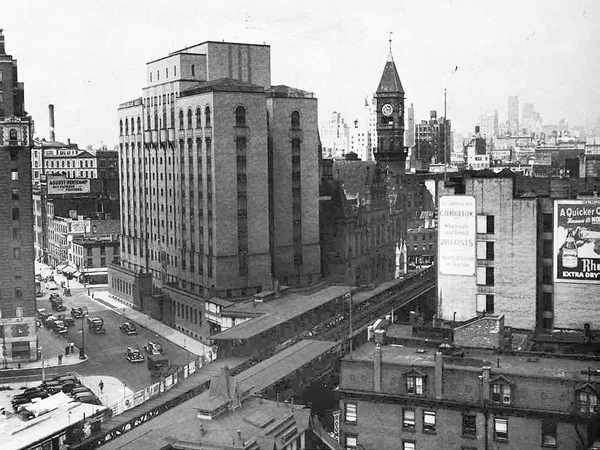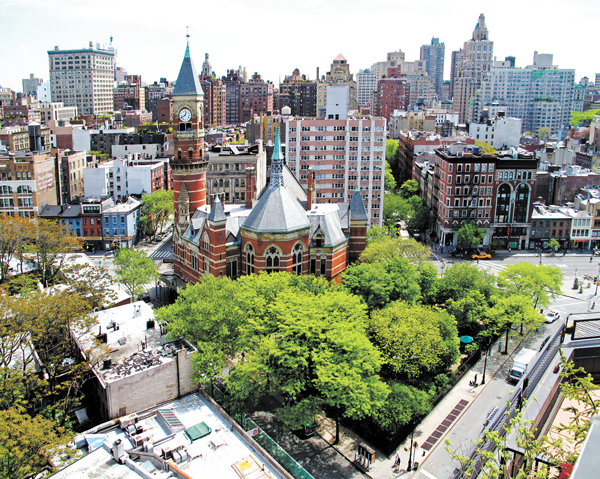
BY REED IDE | M ost people living in Greenwich Village have no idea that just a few short decades ago a 12-story fortress-like prison for women dominated the skyline and the ambience of the neighborhood’s heart. Massive in its architecture, the prison controlled the street life around it. Women in their cells would sit near their barred windows and call down to their husbands, boyfriends or pimps on the sidewalks below. The language was always loud, often angry and colorful. Depending on their point of view, and the proximity of their apartments to the prison, residents either found this an enormous public entertainment or an equally large public nuisance.
The building served as a women’s prison from 1932 until it was closed in 1971. Forty years ago this month, Mayor John Lindsay appeared at the spot where W. 10th St., Greenwich Ave., Christopher St. and Sixth Ave. all converge. On that brisk October Tuesday in 1973, wielding a sledgehammer, he struck a fateful and fatal blow to the infamous Women’s House of Detention. By the spring of the following year the building was but a memory. A colorful, often disturbing era passed into the history books, where, as much of the minutiae of the past, it lies, for the most part forgotten. It was, however, one of the more important events in the shaping of our contemporary Village streetscape.
Where today a lush garden blooms, a sad women’s prison once loomed
The building’s demise did not come easily. In the months before Lindsay’s swing of the hammer, Greenwich Village was in a bit of an uproar over its fate. The great majority of people were squarely in favor of demolition. But a vocal minority persisted in keeping the debate alive as they struggled to save the building for conversion to senior citizen housing. Hearings before the Landmarks Commission and the city’s Board of Estimate, and the Village’s own Community Board 2 took on circus-like atmospheres as irate citizens opposed to demolition shouted their way to publicity, venting their anger in ways that often led to removal and even arrests. As editor of The Villager, I watched it all unfold, and wrote about most of it.

A few weeks ago, I sat in the Jefferson Market Garden that occupies the site of the old House of Detention. It was the day before the equinox. The sun was bright overhead; the thermometer hovered around 80. From my bench next to the rose garden I looked across the central lawn to the small greenhouse. Just beyond that, in my mind’s eye, I could see the short alley that led to the prison’s side entrance.
In my memory’s ear, I could hear Lucille Chasin, telling the city’s Landmarks Commission that the building is, “part of the cityscape, not a weed to be removed from a garden at the whim of ladies in sneakers.”
I could hear Dorothy Ryan: “It would seem that the ‘haves’ of Greenwich Village continuously dictate to the ‘have-nots’ what they should not have! … This building can be put to good use for desperately needed facilities for our senior citizens”
Sitting there, I remembered another sunny warm day at summer’s end in 1973. It was late in the afternoon, the Friday of Labor Day weekend. I was walking home from the Villager office. As I passed that short side entrance alley by the prison, I noticed that the chain-link gate was open. A car was parked in the alley. The side door was open. I walked in, and with no one to stop me I entered the abandoned prison. Whoever belonged to the parked car was nowhere in sight. A row of office rooms stretched across the front of the building. In one, intake records were strewn on the floor. I picked one up. A young woman of 27. Divorced. Two children. Attempted suicide. “Very composed,” wrote the psychologist in the space for his remarks. “States she will return to prostitution for it’s the only way she knows to make money in the amount she wants.”
Fragments of other human beings lay there on the dusty floor of the deserted detention house. “Tense, angry, feels unjustly arrested … frightened about being called down to diagnostic … inflicted cuts on her wrists on two occasions … charged with felonious assault over fight with her girlfriend.” The awesome oppression and hostility, still palpable in the building, startled me.
On the second floor, at the end of a long dark corridor, I found the prison chapel, its heavy velvet drapes masking the reality of the barred windows. Scraps of hymnbooks littered the floor. Near them, a paperbound book of the prophet Isaiah, opened to Chapter 43. Underlined in red were the words, “Fear not for I have redeemed thee. I have called you by name; you are mine.”
On the third floor was the laundry room. Ironing boards lined one entire wall, while great huge washing machines and large pressers occupied the rest of the room. On upper floors, the cells were still furnished. They measured just 4 feet by 8 feet. As conditions worsened, many cells were used to house two women. Those contained their bunk beds, mute testimony to the manner in which the city treated persons awaiting trial, not yet convicted of any crime.
Another floor revealed the kitchen with its great gas stoves and three walk-in refrigerators. Administrative memoranda lined the corridors of floors. “All inmates admitted with head or body lice are to receive their first treatment in the receiving room.” … “Effective August 1, 1970 any inmate receiving an infraction will automatically lose her commissary privileges.”
Small wooden tables and mirrors in one room told of the beauty salon it once was. An X-ray table still stood in one upper-floor room, and dentist chairs and chemistry lab equipment quietly disintegrated in others.
In one room, 10 or more file cabinets stood, unlocked, open to anyone (like myself) who happened by. Abandoned, they contained the detailed records of women incarcerated there, who — let us remember — were not yet convicted of any crime. Intimate details of their lives — unprotected, unrespected, just left behind as collateral damage in the slow death of the building.
On the top floor of the House of Detention were rooms used for recreation, and off those rooms were four rooftop terraces, also for recreation. But even in recreation the inmates were unable to escape the excruciating regimentation of prison life. A sign hung on the wall of one of the rooms: “Attention ladies. Slow records will be played if you do not dance. Dancing will end slow records.”
With my handful of administrative memoranda, religious booklets, inmate records and other materials I had found, I made my way from the roof to the ground floor. I was eager for sunshine, fresh air and freedom. But the Women’s House of Detention had one more thing to show me.
I arrived on the first floor and headed toward the side entrance door. I arrived there to discover, much to my horror, that the heavy metal door was closed – and LOCKED! I was alone inside the prison fortress.
All these years later, I remember thinking, “Rats.” Not as in, Damn it all I’m in a mess now. But rather as in furry creatures that would nibble at my fingers if I were to spend the night in this horrible place.
Checking the two main doors to the outside proved futile. I went from office to office on the Greenwich Ave. side of the building. Each of them had a window. But each window had a mesh cage bolted to the outside of the window frame to contain individual air conditioners. It was well past 5 p.m. Today, I can still conjure up those first rumblings of panic. The shadows seemed to grow. The air became more chill. Those rats became more real!
The reader might well ask at this point, “Why didn’t you simply raise the window and shout to a pedestrian to flag down a police car, or call the police?” All these years later I lack the definitive answer to that question. The truth, I believe, comes in two parts. First, at the age of 25, I think I absolutely dreaded having the story circulated around Greenwich Village that the youthful, yea even callow, editor of The Villager had so foolishly entered that building without telling a single soul what he was doing — had not even put a note on the windshield of the car parked by the side entrance! The embarrassment, I am sure, would have seemed too much to bear at the time.
Second, I may well have not wanted to have anyone, especially anyone official, know I was removing material from the prison. I was indeed taking out individual records of former inmates. And I was removing administrative material and professional evaluations as well. Abandoned property? Perhaps. Perhaps not. During my walk through the building I had already begun to structure an article for the newspaper (an article I actually did write and publish the following week), and that article depended on the materials I had gathered.
At any rate, I continued, in my callow way, what must seem a Quixotic quest. I returned to the offices and opened a window in one of them to see how the mesh cage was attached to the building. Firmly bolted. I looked at several more, until I came upon one that was extensively rusted on the bottom. Alas, a workshop was not at hand. No pliers, no hacksaws were in evidence. Somewhere on that floor, I did manage to find a short length of pipe. I returned to the rusted cage. Using the pipe, I pounded and pried at the mesh, which slowly gave way to my efforts. I was able to break through enough to begin to roll back the mesh, creating a small opening in the bottom of the cage. Hope is made from such moments! I have no idea today how long I worked thus. I remember it as interminable. Visions of those rats were my constant motivation. There did come a moment, finally, when I believed I had created a large enough opening in the bottom of the cage to be able to lower myself through.
And then, good reader, what do you think I did? I called out to a passerby! Man? Woman? I don’t remember. A startled person for sure. I handed them the papers I had collected and then lowered myself through the bottom of the cage, reached for the scaffolding pipe in front of me, and jumped to the ground. The back of my shirt tore on the ragged cage, and my back was scratched in a few places. But I was otherwise unharmed. And free! Shaken, but free.
Across 10th St. two men, Don Taylor and Bob McGrath, owned the Patchin Place Emporium. They were friends of the newspaper, two people I could confide in who would not tell my story like town criers. I made my way to their shop. They got me cleaned up and even sewed up the long tear in my shirt. They lived upstairs from the shop and had also created a wonderful rooftop deck and garden. Better yet, I am happy to say they were both great believers in the healing power of gin. They closed the shop, and took gin bottle, tonic and ice bucket to the roof. There my holiday weekend got its proper beginning.
Today, whenever I walk past or in the Jefferson Market Garden, I think of what once was there. I know that most people see only a beautiful oasis there. All the women imprisoned behind those bars during the 40-year life of the building experienced brokenness, despair, folly and desperation in their lives. They suffered. They failed. And sometimes they triumphed. Always, they had — somewhere inside them — hope. For me, this wonderful space today remembers those women by being a garden of hope.
Ide was editor of The Villager in 1973 and 1974. He now enjoys a lakeside retirement in Massachusetts where he continues to write travel articles, and is a substitute teacher in local schools.


































